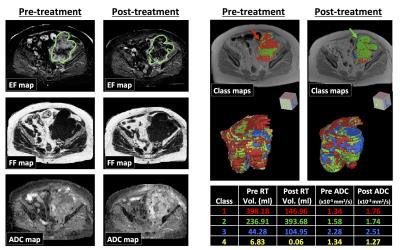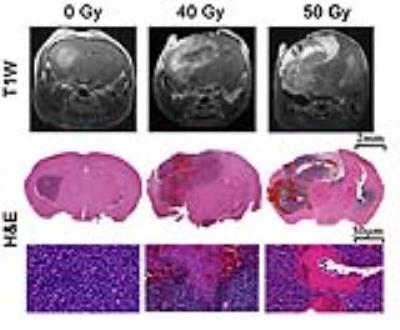Oral
General Cancer Imaging
Thursday, 27 April 2017
| Room 310 |
13:00 - 15:00 |
Moderators: Ferdia Gallagher, Jana Kim |
Slack Channel: #s_cancer
Session Number: O42
13:00
 |
1112.
 |
Eigentumors of dynamic contrast-enhanced MR images of the breast for prediction of treatment failure 
Hui Shan Chan, Claudette Loo, Kenneth Gilhuijs
A method is proposed for predicting long-term treatment failure using “eigentumors”: principal components computed from volumes surrounding breast tumors in contrast-enhanced images. The dataset contains pre-treatment scans of 563 consecutively included patients with early-stage breast cancer with median follow-up of 86 months. Principal components of washin and washout in box-shaped regions surrounding the tumors were computed, and LASSO and logistic regression were used to construct a model for predicting the probability of treatment failure. ROC analysis yields a bootstrapped performance of 0.73, and bootstrapped Kaplan-Meier survival curves based on the model’s outcome show significant separation (χ=32.89, P < 0.0001).
|
13:12
 |
1113.
 |
Radiomic Analysis Differentiates between True Progression and Pseudo-progression in Glioblastoma patients: A Large Scale Multi-institutional Study 
Aikaterini Kotrotsou, Srishti Abrol, Nabil Elshafeey, Islam Hassan, Dunia Giniebra Camejo, Ahmed Hassan, Tagwa Idris, Ahmed Salem, Kamel El Salek, Ahmed Elakkad, Kristin Alfaro-Munoz, Shiao-Pei Weathers, Fanny Moron, John deGroot, Meng Law, Pascal Zinn, Rivka Colen
The benign treatment-related imaging changes may pose a challenge in appropriate clinical decision making for the neuro-oncologists. The post-treatment changes are usually benign and differ largely in management approach from a progressive tumor. In this study, 304 glioblastoma patients were evaluated retrospectively to study the ability of radiomic analysis to distinguish the post-treatment changes from a truly progressive disease. 3D volumetrics using 3D Slicer 4.3.1 and texture analysis of the lesions were performed. On LOOCV, sensitivity and specificity of 97% and 72% were obtained respectively. We concluded that radiomics can differentiate between the progressive disease and pseudo-progression in glioblastoma patients.
|
13:24
|
1114.
 |
Supervised machine-learning enables segmentation and evaluation of heterogeneous post-treatment changes in multi-parametric MRI of soft-tissue sarcoma 
Matthew Blackledge, Jessica Winfield, Aisha Miah, Dirk Strauss, Khin Thway, Veronica Morgan, David Collins, Dow-Mu Koh, Martin Leach, Christina Messiou
Multi-parametric MRI enables non-invasive response assessment in heterogeneous soft-tissue sarcomas, but evaluation of post-treatment changes in MRI parameters requires segmentation of cellular tumour-tissue, which might be expected to respond to treatment, from necrotic/cystic regions and fat. Six supervised Machine-Learning methods were explored using a randomized cross-validation approach, from which a candidate method (automatic Kernel Density Estimation) was selected owing to its high validation accuracy and automatic selection of hyper-parameters. The automatic-KDE method enabled evaluation of post-radiotherapy changes in volumes and ADCs of each tumour component, and provided visual depiction of heterogeneous changes in multi-parametric MR-images.
|
13:36
 |
1115.
 |
Hyperpolarized 13C Dynamic Breath-held Molecular Imaging to Detect Targeted Therapy Response in Patients with Liver Metastases 
Zihan Zhu, Irene Marco-Rius, Michael Ohliger, Lucas Carvajal, Jeremy Gordon, Hsin-Yu Chen, Ilwoo Park, Peng Cao, Peter Shin, Eugene Milshteyn, Cornelius von Morze, Marcus Ferrone, James Slater, Zhen Wang, Peder Larson, Rahul Aggarwal, Robert Bok, John Kurhanewicz, Pamela Munster, Daniel Vigneron
New clinical trials are using hyperpolarized 13C molecular imaging technology to evaluate tumor metabolic activity and response to targeted drug therapies. The goal of this work was to develop and apply an experimental setup for HP 13C MR investigations of cancer metastases to liver. In this study, patients with liver metastases were imaged and the results demonstrated sufficient SNR and data quality for the quantification of the localized conversion rate of [1-13C]pyruvate to [1-13C]lactate through lactate dehydrogenase (LDH), which is a pathway targeted by numerous emerging pharmaceutical agents and currently prescribed Everolimus.
|
13:48
|
1116.
 |
Assessing Response Heterogeneity following Radium 223 administration using Whole Body Diffusion Weighted MRI 
Matthew Blackledge, Dow Koh, David Collins, Erica Scurr, Julie Hughes, Martin Leach, Chris Parker, Nina Tunariu
Whole-Body Diffusion-Weighted-MRI is emerging as an imaging response biomarker in metastatic bone disease. Documentation of mixed therapeutic response is a key recommendation of the Prostate Cancer Working Group as recognition of coexistence of mixed response to therapy and clinical benefit. Radium-223 has shown efficacy in prostate cancer patients with symptomatic bone metastases. Monitoring Radium-223 therapy efficacy treatment is challenging, as Radium-223 administration can be associated with flare in pain, PSA and Bone Scan. These pilot data demonstrate that Radium-223 administration is associated with an increase in bone metastases ADC values together with a mixed response pattern.
|
14:00
|
1117.
 |
Whole-Body Diffusion-Weighted Imaging at 1.5T for assessment of treatment response in non-Hodgkin lymphoma 
Xiaoyi Wang, Yanfeng Zhao, Ning Wu, Han Ouyang, Lizhi Xie
The diagnostic capability between WBDWI with contrast enhanced CT was compared in malignant lymphoma diagnosis. We found that WBDWI is a powerful tool on diagnosing non-Hodgkin(NHL) lymphoma by comparing with contrast enhanced CT. Chemotherapy causes rapid decrease of the restriction of water molecules diffusion movement, ADC-min could be valuable tools for treatment response evaluation of NHL. We recommended WBDWI examination for patients with NHL.
|
14:12
|
1118.
 |
Intravoxel incoherent motion diffusion-weighted MRI during chemoradiation therapy to monitor treatment response in human papillomavirus head and neck squamous cell carcinoma 
Ramesh Paudyal, Jung Oh, Nadeem Riaz, Praveen Venigalla, Jingao Li, Vaios Hatzoglou, Jonathan Leeman, David Aramburu Nunez, Yonggang Lu, Joseph O. Deasy, Nancy Lee, Amita Shukla-Dave
This study aims to monitor treatment response in human papillomavirus (HPV) head and neck squamous cell carcinoma using pre- and intra-treatment (TX) week 1, 2 and 3 imaging metrics derived from intravoxel incoherent motion (IVIM) DW-MRI. An unsupervised hierarchical clustering with a distance based on the Pearson correlation coefficient was performed using the relative percentage changes in D, f and D* to investigate similarities among features and samples. D showed a significant increase during treatment in complete response (CR) group. A heat map generated from the unsupervised hierarchical clustering identified subtypes in HPV positive [+] HNSCC patients.
|
14:24
 |
1119.
 |
Multiparametric MRI with spatiotemporal evaluation reveals potential therapy response biomarkers for 177Lu-octreotate therapy of mice with human neuroendocrine tumor 
Mikael Montelius, Johan Spetz, Oscar Gustafsson, Evelin Berger, Ola Nilsson, Maria Ljungberg, Eva Forssell-Aronsson
Tissue parameters derived from multiparametric MRI were evaluated as potential imaging biomarkers for therapy response assessment in mice with human neuroendocrine tumor treated with 177Lu-octreotate. Animals were imaged before and repeatedly after 177Lu-octreotate treatment, using T2w, IVIM-DWI, DCE-MRI, T1- and T2*-mapping techniques. MR-parameters were evaluated regionally and longitudinally, and quantitative proteomics was used to evaluate underlying biological response in central and peripheral tumor separately. Several MR-parameters showed strong correlation with tumor response, as verified by MRI-based tumor volume measurements, but also with proteins associated with radiobiological effects on tumor tissue. Spatial and temporal evaluation increased sensitivity of the methods.
|
14:36
 |
1120.
 |
Irradiated Brain Parenchyma Promotes Virulent Proliferation of Naive Glioma Cells: Mouse Model of Recurrent Glioblastoma 
Chong Duan, Ruimeng Yang, Liya Yuan, John Engelbach, Sonika Dahiya, Christina Tsien, Keith Rich, Joseph Ackerman, Joel Garbow
For many years, research on recurrent glioblastoma has largely focused on therapy-induced cancer-cell changes. Herein, we show that gliomas resulting from na´ve, non-irradiated DBT tumor cells implanted into irradiated mouse brains grow more rapidly than tumors resulting from na´ve DBT cells implanted into non-irradiated mouse brains. Likewise, survival post-implantation is reduced, and MRI and histology document striking differences between na´ve tumors implanted in irradiated vs. non-irradiated brain. Collectively, these data provide new insights into the enhanced invasiveness of recurrent gliomas and, importantly, demonstrate a novel recurrent glioblastoma model for further investigation of the long-term effects of radiotherapy on tumor microenvironment.
|
14:48
|
1121.
 |
Assessing Metabolic Intervention in Acute Myeloid Leukemia with a Glutaminase Inhibitor by Hyperpolarized Magnetic Resonance 
Niki Zacharias Millward , Sriram Shanmugavelandy, Jaehyuk Lee , Natalia Baran, Juliana Velez, Prasanta Dutta , Marina Konopleva , Pratip Bhattacharya
Acute myeloid leukemia (AML) is glutamine addicted cancer. We determined if hyperpolarized pyruvate could be utilized to detect in vivo metabolic changes in AML (OCI-AML3 cell line) bearing mice after CB839 (glutaminase inhibitor) treatment. We found a reduction of pyruvate to lactate conversion after treatment. In vitro analysis of OCI-AML3 reveal that NADH/NAD+ ratio, ATP, hydrogen peroxide levels and respiratory capacity reduce in CB839 treated cells compared to vehicle controls. Our data supports the hypothesis that in AML glutamine generates reducing equivalences by the citric acid cycle and inhibiting this process with CB839 reduces the rate of conversion of pyruvate to lactate.
|
|












